Home Camera Articles FOR SALE Orders I Buy / Wants Repairs Books Adapters
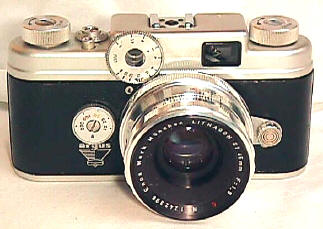
Home Camera Articles FOR SALE Orders I Buy / Wants Repairs Books Adapters
Geiss Modified Argus C-4
Best Interchangeable Lens Argus
In the early 1950's Argus had the two best selling 35's in America: the famous C3 "Brick" and its upscale brother the C-4. Bestsellers? Why yes! The C4 sold more than 300,000 cameras, and the C3 well over 2,000,000! Put in perspective, that is over FOUR times the best two selling Leicas combined, the M3 and M6!! The Argus Success played a major and often unappreciated part in 35mm history, helping ensure the popularity and survival of the 35 format!! Without Argus to really cement 35's firm popularity in the American market, there is no telling what film format Kodak would be pushing off on us in their "film flavor for the decade" style of marketing.
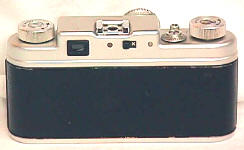 Despite its popularity, the C-4 lacked one important feature for the
serious amateur photographer: interchangeable lenses. The Chicago firm of Geiss set out to remedy that, modifying C-4's to take
a series of four German lenses made by Enna: 35/4.5
Lithagon, the rare and impressive 45/1.9 Lithagon, 100/4.5 Lithagon and 135/2.8
Lithagon, plus the American made 50/2.8 Cintar. Apparently these conversions were
only done for about two years, from 1954 to 1956, until the new C-44 came out. These Geiss modified C4's and C4R's are hard to find today, the lenses are
even harder. Unusual for Argus, the failure of the Geiss C-4 seems to be
marketing. It was not heavily promoted like the later C-44/R.
Despite its popularity, the C-4 lacked one important feature for the
serious amateur photographer: interchangeable lenses. The Chicago firm of Geiss set out to remedy that, modifying C-4's to take
a series of four German lenses made by Enna: 35/4.5
Lithagon, the rare and impressive 45/1.9 Lithagon, 100/4.5 Lithagon and 135/2.8
Lithagon, plus the American made 50/2.8 Cintar. Apparently these conversions were
only done for about two years, from 1954 to 1956, until the new C-44 came out. These Geiss modified C4's and C4R's are hard to find today, the lenses are
even harder. Unusual for Argus, the failure of the Geiss C-4 seems to be
marketing. It was not heavily promoted like the later C-44/R.
In 1954, the cost of a standard C-4 was $84.50, with the case $7.50 additional. The Geiss modified C-4 was only $10 more at $94.50. The 35mm and 100 lenses sold for $66.50, the cases being $4.95 more. The auxiliary viewfinder was $16.95 with case.
Before going further, I should explain that the C-4 actually looks like a camera, unlike its cousin the C-33. The C-4 has a sleek business like appearance about it, proclaiming to the Argus faithful that it was the next step up towards photographic nirvana. C-4 features include
An excellent combined rangefinder-viewfinder with a very bright round rangefinder spot, and a large field finder easily seen by glasses wearers. As proclaimed by Modern Photography, the C-4's "viewing system is one of the best seen on any camera regardless of price."
A very nice focusing feature, compared to the Brick C-33, is the choice of focusing by either the rangefinder wheel OR by turning the lens barrel. If you are used to those pesky Leicas, lens barrel focusing is especially convenient and potentially faster too, compared to the RF wheel alone.
A streamlined die cast all metal body with all metal construction, a very handsome appearance.
Hot shoe with M and X electronic flash settings, unusual for the time.
Very easy film loading, the entire back removes for very easy access.
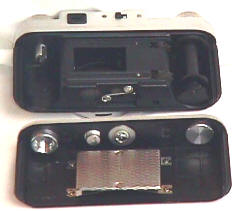

The C-4 lacks slow speeds, the slowest shutter speed being 1/10th.
The C-4 does not take the front mounted selenium meter, unlike the later C-33, C-44/R.
The C-4's top mounted exposure counter is manually set, and counts backward.
The shutter release is unusually long, but smooth.
Geiss Lens Mount
This is kind of a complicated mount, yet it is much easier to use than the C-44 mount which followed.
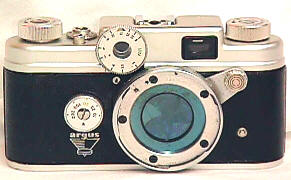
That arm on the lens mount locks or unlocks the lens. It is now in the "UP" unlocked position. Swung down, the lens is locked, and you then rotate the arm's round end knob, to finally secure it on the locking post shown on the body.
To mount a lens, 1st set the camera rangefinder dial at infinity. Set the Enna lenses on infinity, matching the click stopped infinity marking with the triangular "Zero" position on the depth of field scale. Insert the lens to mesh with the gearing on the camera, swing the lock arm down, and turn the locking knob.
You're right, it's not a great lens mounting system, and the mount on the C-33 is easier and faster. Yet, by Argus standards, it was an outstanding design. Too bad it was not used for the later C-44.
Geiss C4 Lenses
Left to right, 45/1.9 on camera, 135/3.5, 35/4.5, 100/4.5, 50/2.8 Cintar on camera.
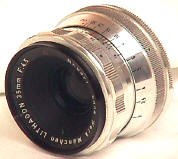
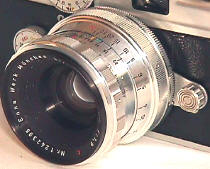
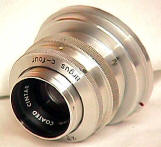
Left to right, 35/4.5 Lithagon, 45/1.9 Lithagon, 50/2.8 Cintar.
35/4.5 Enna Lithagon: f/stops 4.5 to 16, filter size Series 7, deep set front element which does not need a lens shade, aluminum barrel construction, non-rotating helical, closest focus 3 feet, very nicely finished. Weight 6.5 oz. Four element construction.
45/1.9 Enna Lithagon: f/stops 1.9 to 16, filter size Series 7, deep set front element, aluminum barrel construction, non-rotating helical, closest focus 3 feet, very nicely finished. This is a particularly rare lens, probably the rarest of all Argus RF lenses. Weight 7.5 oz. 5 elements?
50/2.8 American made Cintar: f/stops 2.8 to 22, filter size 30, deep set front element, aluminum barrel construction, non-rotating helical, closest focus 3 feet, very nicely finished. The most common C-4 Geiss lens, and the only one which does NOT have a depth of field scale. Weight 7 oz. Three element triplet design.
100/4.5 Enna Tele-Lithagon: F/stops 4.5 to 22, Filter size Series 5. Four elements. This seems to be hardest to find Geiss Tele.
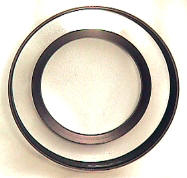
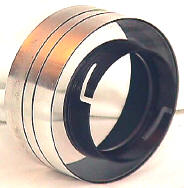
135/3.5 Lithagon with its huge bayonet shade. Note the unusual design. Rather than a see through hood like virtually all other manufacturers, allowing the photog to see through the hood at the subject, Geiss Enna opted for GLASS. The hood diameter is 81mm, with a bayonet size of 54mm. That's right, the bayonet mount is attached to a glass circle, which is attached to the hood. Amazing.
F/stops 3.5 to 22, filter size 52mm, aluminum barrel construction, non-rotating helical, closest focus 5 feet, very nicely finished. Weight 7 oz.Weight with hood 17 oz.
Left to right: 135/3.5, 100/4.5, 50/2.8, 45/1.9, 35/4.5
The Geiss C-4 is my choice as "Best Performing" Argus interchangeable lens rangefinder, over the later C-44 and C-44 R:
- The Geiss mount is considerably EASIER to mount and dismount lenses than the C-44/R.
- The Geiss lenses have a better quality of fit and finish to them, IMHO, than the C-44/R lenses.
- The Geiss lenses have a wider focal length range, from 35 to 135, rather than the 35 to 100 range of the C-44/R.
- As a side note, I personally prefer the all metal advance and rewind knobs of the C4 and C44 to the cheaper looking plastic things on the C-44R.
The Geiss C4 on the left, on the right the C-44R.
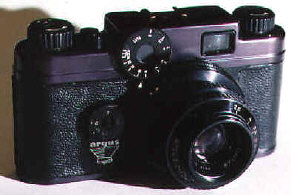
The rarest C-4? Probably the US Army black anodized version. Photo courtesy Phillip Sterritt.
For more info Visit: the Argus Collector's site and the Argus Discussion Forum
Home Camera Articles FOR SALE Orders I Buy / Wants Repairs Books Adapters
Revised: January 31, 2016 . Copyright � 1998-2002 Stephen Gandy. All rights reserved. This means you may NOT copy and re-use the text or the pictures in ANY other internet or printed publication of ANY kind. Information in this document is subject to change without notice. Other products and companies referred to herein are trademarks or registered trademarks of their respective companies or mark holders.